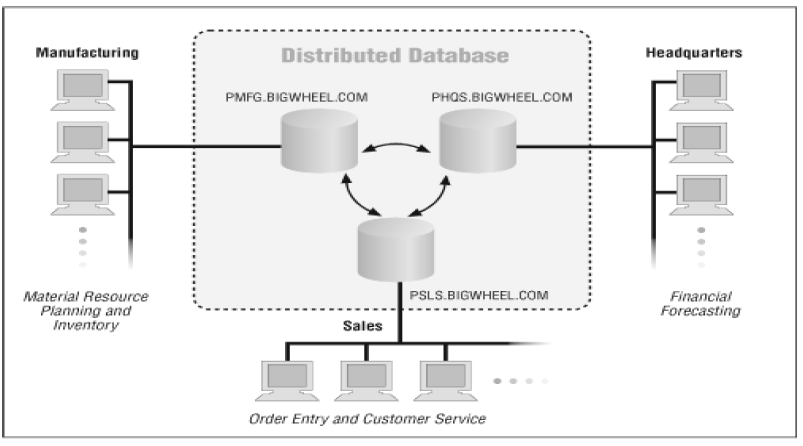ABSTRACT
In database and information systems, increasing attention has been focused lately on parallel and distributed database systems. The future of large database systems lies into the realm of distributed computing. The main reason for this is that distributed computing can be constructed at a low cost without the need for any specialized technology, using existing sequential computers and relatively cheap computer networks.
The basic motivations for distributed databases are improved performance, increased availability, share ability, expandability, and access flexibility. Oracle9i is one of the most famous database management systems that provide distributed features. Oracle9i supports transparent distributed gains to access data from multiple databases. It also provides many other distributed features, such as transparent distributed transactions and transparent automatic two-phase commit.
This paper presents a distributed registration database system using Oracle9i distributed features such as replication and fragmentation. The analysis and design steps of the distributed registration database system are shown as well as to the practical steps required for implementing the distributed database system using Oracle9i.
ORACLE9I DISTRIBUTED FEATURES
There is a great deal of confusion surrounding the various products and terminology from Oracle. It’s worthwhile to clarify some of these terms up front so the reader gets the most benefit from this paper. This section introduces Oracle9i terminology and distributed features related to the work presented in this paper.
- Distributed Terminology
- Transparency
- Replication
- Database Link
Figure 1 illustrates an environment in which data in two or more database instances is accessible as though this data were in a single instance. This access may be read-only, or it may permit updates to one or many instances. The referenced data may be real time, or it may be seconds, hours, or days old. Generally, the different database instances are housed on different server nodes, and communication between them is via Net8 (for Oracle9i). In addition to database servers, a distributed database system usually includes application servers and clients.
DESIGN OF THE DISTRIBUTED REGISTRATION SYSTEM
The tables of colleges, departments, instructors and courses are the same as in both sites, that’s why the tables are replicated in both sites. The information about the students in each campus is stored in its site, so the student table; teach table (schedule), and the registration table are fragmented. Table 1 shows the distributed technique used for each table and the corresponding technique in Oracle9i (Fodor, 2007; Hoffer et al., 2008). The entity relationship diagram for the distributed registration system is shown in Figure 2.
DEVELOPMENT AND IMPLEMENTATION

Table 3. Recommended initial table-space Requirements
In this section, the implementation steps of the distributed registration database system using Oracle9i will be described. Oracle9i DBMS was installed with its global name in both sites, Basrah_db and Mesan_db. After setting a connection between the two sites, the parameters that must be set or added to the initSID.ora file are initialized as in Table 2. The recommended initial table space Requirements are shown in Table 3.
CONCLUSION
The future of huge databases relies on the network based parallelism. Distributed and parallel databases are becoming one of the hot topics in the last decade. The need for more distribution of data is increasing as we rely more on the net. The internet and the World Wide Web significant developments are encouraging DBMS vendors on making their products web-enabled. This is leading to distributing data in many servers over the net.
Distributed database management systems are commercially available. Oracle is one of the leading database corporations who moved early toward distribution. Oracle9i is one of the most common database management systems that supports distributed features. It supports transparent data access across multiple databases. Also, it provides many other distributed features, such as transparent distributed transactions and transparent automatic two-phase commit. This paper presented a distributed database registration information system using Oracle9i distributed features such as replication and fragmentation. In addition to that, the paper shows the practical steps in implementing a distributed database using Oracle9i in a local area network.
Source: University of Basrah
Author: Sana J. Alyaseri
>> List of Final Year B.E/B.TECH Student DBMS Projects using Oracle

